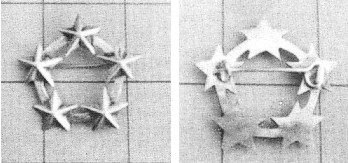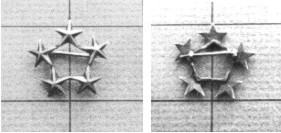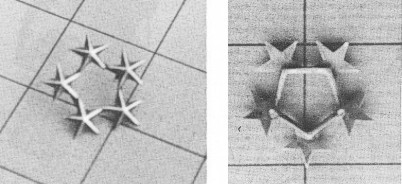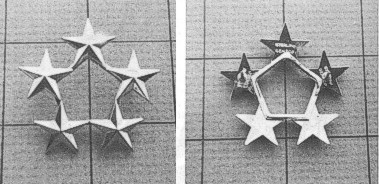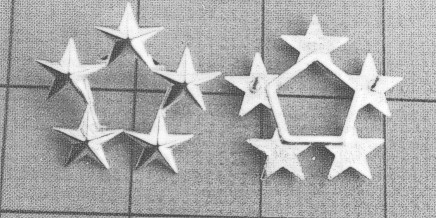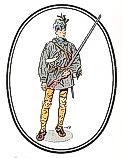 |
THE
COMPANY OF MILITARY HISTORIANS |
|
|
FIVE STAR
INSIGNIA by Stephen M. Henry With
the death of General of the Army Omar N. Bradley in April of 1981,
the five-star
rank passed into American history. And it is that passing which seems to
make a brief survey of the five-star insignia of the General of the Army
and the Admiral of the Fleet appropriate.
Figure 1 shows an insignia attributed to General of the Army Eisenhower. The unique features of this particular insignia are that it is cut from one piece of silver stock, it incorporates a circular background device into the design, and the pin and safety catch on the reverse are typically British. It is not marked in any way. These features would tend to indicate that this is not only a theater made piece, but probably a prototype piece made up for General Eisenhower. This seems very probable when one considers that at the time of his promotion he was at his headquarters in France, the day before the Germans were to launch their winter offensive in the Ardennes -- the eve of the Battle of the Bulge!
Figure 2 is unattributed, but is considered to be of the type first manufactured as it is both pin-backed and of sterling silver. It is of a smaller size which per the regulations would have been worn on the overseas cap or on the shirt collar. The only mark which appears on this insignia is, "sterling." Note that there is no circular background device as in figure I and that where the points of the stars join, a pentagon is formed. This pentagon form is common in each of the figures to follow.
Figure 3 is attributed to Fleet Admiral Nimitz. It too is of regulation size for the collar or overseas hat, is marked only "sterling," and is clutch backed.
Figure 4 is unattributed. It is of the regulation size to be worn on the shoulder of the uniform coat and thus was intended for General of the Army, (Fleet Admiral would have worn either shoulder boards with five stars embroidered into them or the appropriate cuff designation). This piece too is clutch backed and is marked in two lines, "sterling" and "GEMSCO. "
Figure 5 are a pair which is attributed to General of the Army Omar Bradley. They are of the regulation size to be worn on the shoulder and are clutch backed. They are marked in two lines, "silver filled," "220." This is quite appropriate as General of the Army Bradley remained on active duty until his death in 1981. REFERENCES Association of Graduates, Register
of Graduates,
USMA, New York,
1982. U.S. Army, "Army Regulations: 600‑35, Prescribed Service
Uniform," 18 April 1945. McHenry, Robert, editor, Webster's
American Military Biographies.
Springfield, Mass., 1978. Nylander,
Maureen, The Generals. New York,
1974. Reynolds, Clark G., Famous American Admirals. Van, New York, 1978.
This article first appeared in the Winter 1984 issue of The Military Collector and Historian. © 1984 The Company of Military Historians. |
||
